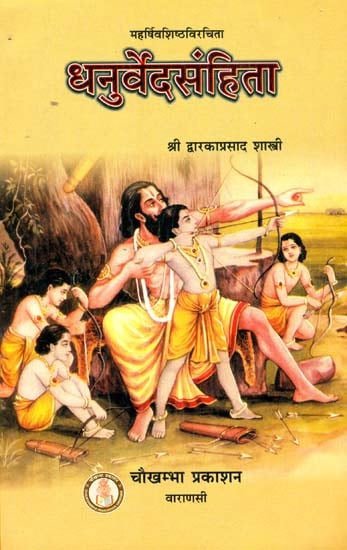Dhanurveda Samhita [sanskrit]
3,015 words
The Sanskrit text of the Dhanurveda-samhita attributed to Vasishtha. Dhanur Veda is a type of ancient India science whose roots date to the 2nd millenium BCE. It is counted among the Upavedas literature. This specific version of the Dhanurveda contains roughly 240 sections of Sanskrit text.
Verse 1.19
अङ्गन्यासं ततः कार्य्यं शिवोक्तं सिद्धिमिच्छता ।
आचार्य्येण च शिष्यस्य पापघ्नं विघ्ननाशनम् ॥ १९ ॥
aṅganyāsaṃ tataḥ kāryyaṃ śivoktaṃ siddhimicchatā |
ācāryyeṇa ca śiṣyasya pāpaghnaṃ vighnanāśanam || 19 ||
Note! The following is not a translation of the above verse, but merely an arbitrary extract of the English text.
If one desires perfection, one should then place the limbs as described by Lord Shiva. It destroys the sins of the disciple and the acarya and destroys all obstacles.
English translation by Hardayalu Swami (2001) Buy now!
Glossary of Sanskrit terms
Note: This extracts Sanskrit terms and links to English definitions from the glossary, based on an experimental segmentation of verse (1.19). Some terms could be superfluous while some might not be mentioned. Click on the word to show English definitions.
Anganyasa, Tatah, Tad, Tata, Karyin, Shiva, Ukta, Siddhi, Icchata, Icchat, Aca, Aryi, Ena, Shishya, Papaghna, Vighnanashana,
Analysis of Sanskrit grammar
Note: this is an experimental feature and only shows the first possible analysis of the Sanskrit text (Verse 1.19). If the system was successful in segmenting the sentence, you will see of which words it is made up of, generally consisting of Nouns, Pronouns, Verbs, Participles and Indeclinables. Click on the link to show all possible derivations of the word.
- Line 1: “aṅganyāsaṃ tataḥ kāryyaṃ śivoktaṃ siddhimicchatā ”
- aṅganyāsam -
-
aṅganyāsa (noun, masculine)[adverb], [accusative single]
- tataḥ -
-
tataḥ (indeclinable adverb)[indeclinable adverb]tataḥ (indeclinable correlative)[indeclinable correlative]tataḥ (indeclinable)[indeclinable]tad (noun, neuter)[ablative single], [ablative dual], [ablative plural]tata (noun, masculine)[nominative single]√tan -> tata (participle, masculine)[nominative single from √tan class 8 verb]sa (noun, masculine)[ablative single], [ablative dual], [ablative plural]sā (noun, feminine)[ablative single], [ablative dual], [ablative plural]
- kāryya -
-
kāryin (noun, masculine)[compound], [adverb], [nominative single]kāryin (noun, neuter)[compound], [adverb], [nominative single], [vocative single], [accusative single]
- am -
-
a (noun, masculine)[adverb], [accusative single]ā (noun, feminine)[adverb]e (noun, masculine)[accusative single]
- śivo -
-
śiva (noun, masculine)[compound], [vocative single]śiva (noun, neuter)[compound], [vocative single]śivā (noun, feminine)[nominative single]
- uktam -
-
ukta (noun, masculine)[adverb], [accusative single]ukta (noun, neuter)[adverb], [nominative single], [accusative single]uktā (noun, feminine)[adverb]√vac -> ukta (participle, masculine)[accusative single from √vac class 2 verb], [accusative single from √vac class 3 verb]√vac -> ukta (participle, neuter)[nominative single from √vac class 2 verb], [accusative single from √vac class 2 verb], [nominative single from √vac class 3 verb], [accusative single from √vac class 3 verb]
- siddhim -
-
siddhi (noun, feminine)[accusative single]
- icchatā -
-
icchatā (noun, feminine)[nominative single]√iṣ -> icchat (participle, masculine)[instrumental single from √iṣ class 6 verb]√iṣ -> icchat (participle, neuter)[instrumental single from √iṣ class 6 verb]
- Line 2: “ācāryyeṇa ca śiṣyasya pāpaghnaṃ vighnanāśanam ”
- ācā -
-
āca (noun, masculine)[compound], [vocative single]√ac (verb class 1)[perfect active first single], [perfect active second plural], [perfect active third single]
- aryye -
-
aryī (noun, feminine)[compound], [adverb], [nominative single], [vocative single]
- eṇa -
-
eṇa (noun, masculine)[compound], [vocative single]
- ca -
-
ca (indeclinable conjunction)[indeclinable conjunction]ca (noun, masculine)[compound], [vocative single]ca (noun, neuter)[compound], [vocative single]
- śiṣyasya -
-
śiṣya (noun, masculine)[genitive single]śiṣya (noun, neuter)[genitive single]√śās -> śiṣya (participle, masculine)[genitive single from √śās class 2 verb]√śās -> śiṣya (participle, neuter)[genitive single from √śās class 2 verb]√śiṣ -> śiṣya (participle, masculine)[genitive single from √śiṣ class 10 verb]√śiṣ -> śiṣya (participle, neuter)[genitive single from √śiṣ class 10 verb]
- pāpaghnam -
-
pāpaghna (noun, masculine)[adverb], [accusative single]pāpaghna (noun, neuter)[adverb], [nominative single], [accusative single]
- vighnanāśanam -
-
vighnanāśana (noun, masculine)[adverb], [accusative single]vighnanāśana (noun, neuter)[adverb], [nominative single], [accusative single]
Other editions:
Also see the following editions of the Sanskrit text or (alternative) English translations of the Verse 1.19
Dhanurveda Samhita (धनुर्वेदसंहिता)
by Hardayalu Swami (2001)
Publisher: Khemraj Shrikrishnadass
Buy now!
Vasistha’s Dhanurveda Samhita
by Purnima Ray (2023)
Publisher: Khemraj Shrikrishnadas; ISBN-10: 818670289X; ISBN-13: 9788186702895; 88 pages including 18 illustrations;
Buy now!
Dhanurveda Samhita (धनुर्वेदसंहिता) (संस्कृत एवं हिंदी अनुवाद)
by Shri Dwarka Prasad Shastri (2007)
Title: Dhanurveda Sanhita (Hindi translation); Publisher: Chaukhambha Prakashan, Varanasi; 84 pages including 11 illustrations; Author: महर्षि वशिष्ठ (Maharshi Vashistha); Foreword by Dr. Chakradhar Bijalwan.
Buy now!![Dhanurveda Samhita [sanskrit] - book cover](/uploads/a/Dhanurveda-Sanskrit.jpg)

